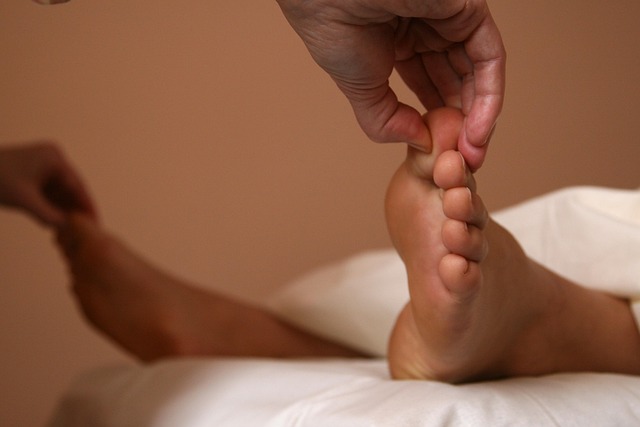Proper posture and alignment are crucial for back health, preventing chronic pain, stiffness, and headaches. Solutions include yoga, Pilates, chiropractic adjustments, ergonomic workspaces, core-strengthening exercises, and posture support braces. Integrating these practices improves physical well-being, relieves back pain, and enhances overall stability, focusing on posture correction exercises and alignment therapy. Sedentary lifestyles contribute to discomfort, so start with ergonomic setups, daily stretching, yoga for posture, Pilates for alignment, chiropractic adjustments, core strengthening, and posture support braces for lasting improvements.
Back pain is a common struggle, often exacerbated by poor posture. This comprehensive guide explores effective posture and alignment solutions to alleviate discomfort and prevent future issues. We delve into powerful posture correction exercises for daily integration, offering routines that target key muscle groups for optimal alignment therapy. Additionally, discover the benefits of alternative therapies like yoga for posture, chiropractic adjustments, core strengthening with Pilates, and ergonomic workspace tips featuring supportive gear to create a healthy environment.
- Understanding Posture and Its Impact on Back Health
- Posture Correction Exercises for Daily Practice
- Alternative Therapies: Yoga, Chiropractic, and More
- Ergonomic Workspace Setup and Supportive Gear
Understanding Posture and Its Impact on Back Health

Maintaining proper posture and alignment is crucial for overall back health and well-being. Posture refers to the position in which your body is aligned, from head to toe, while performing everyday activities or engaging in specific exercises. Poor posture can lead to a range of issues, including chronic back pain, neck stiffness, headaches, and even digestive problems. It often results from muscle imbalances, weak core strength, or improper lifting techniques. By understanding the impact of posture, individuals can take proactive steps towards alleviating back pain and improving their overall quality of life.
Many solutions exist to correct posture and promote better alignment, such as yoga for posture, Pilates, chiropractic adjustments, and ergonomic workspace tips. Posture and alignment exercises, like core strengthening routines, target specific muscles to support the spine and improve stability. Additionally, posture support braces can be beneficial for those with persistent issues or during recovery from injuries. Incorporating these practices into daily life not only reduces back pain but also enhances overall physical well-being.
Posture Correction Exercises for Daily Practice

Maintaining proper posture and alignment is essential for reducing back pain and preventing future discomfort. Incorporating simple yet effective posture correction exercises into your daily routine can significantly improve your overall ergonomic workspace tips. These practices target key muscle groups, including your core, which plays a crucial role in supporting your spine and maintaining neutral spinal alignment therapy.
Yoga for posture and Pilates for alignment are popular choices, offering gentle yet powerful stretches and strengthening routines. Incorporating these activities can help retrain your body to hold itself in correct positions, reducing the risk of strain and injury. For those seeking more direct chiropractic adjustments, professional care combined with specific core strengthening routines and the use of posture support braces can provide even greater benefits, ensuring long-term relief from back pain.
Alternative Therapies: Yoga, Chiropractic, and More

Posture and alignment solutions go beyond traditional exercises. Yoga, for instance, offers a holistic approach to improving posture through a combination of stretching, strengthening, and mindfulness practices. Poses like the Cobra, Cat-Cow, and Warrior II are particularly effective in opening up the spine and promoting better alignment. Additionally, yoga encourages awareness of body positions during daily activities, translating into lasting postural improvements.
Chiropractic adjustments play another crucial role in posture correction exercises. Chiropractors specialize in diagnosing and treating musculoskeletal disorders, often providing relief from back pain through manual manipulation of the spine. Ergonomic workspace tips, such as maintaining proper chair height and using supportive equipment, complement these alternative therapies. Core strengthening routines via Pilates or targeted exercises can further enhance postural stability by engaging muscles that support the spine. Even posture support braces can offer temporary assistance for those with persistent issues, allowing them to practice correct alignment while recovering.
Ergonomic Workspace Setup and Supportive Gear

A significant portion of daily discomfort and back pain stems from improper posture and misalignment, especially in sedentary lifestyles. Addressing this issue begins with an ergonomic workspace setup. Invest in a chair that offers lumbar support, adjust your desk height to promote a neutral spine position, and utilize standing desks or exercises like sitting on an exercise ball to encourage active sitting. Incorporate posture and alignment solutions like yoga for posture, pilates for alignment, or even simple stretching routines throughout the day to relieve tension and strengthen muscles supporting your core.
For added support, consider posture correction exercises such as chiropractic adjustments and core strengthening routines. Gear like posture support braces can also provide temporary assistance while training your body to adopt better habits. Remember, combining these ergonomic workspace tips with targeted physical activities is key to achieving lasting improvements in posture correction and reducing back pain.
Improving your posture and aligning your body correctly is a multifaceted approach that combines regular exercise, alternative therapies, and thoughtful workspace design. By incorporating posture correction exercises like core strengthening routines and Pilates into your daily routine, trying yoga for improved flexibility and alignment, or exploring chiropractic adjustments for long-term relief, you can achieve lasting results. Don’t forget the power of ergonomic workspace tips and supportive gear to reduce strain throughout the day. With these comprehensive posture and alignment solutions, you’re well on your way to a pain-free, healthier back.
